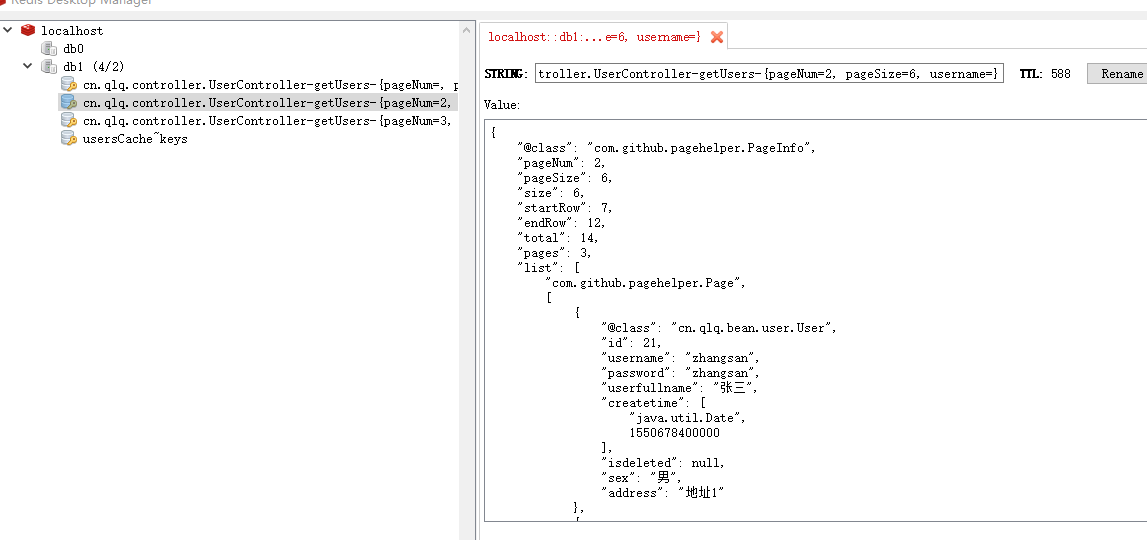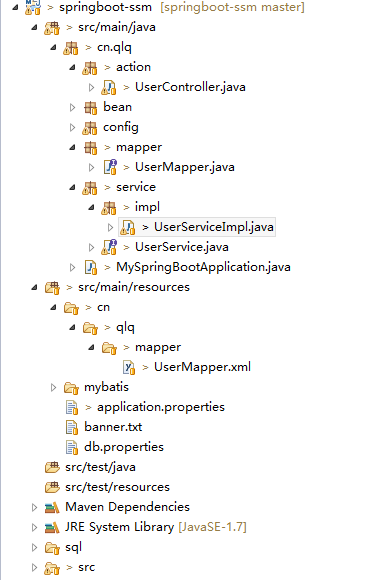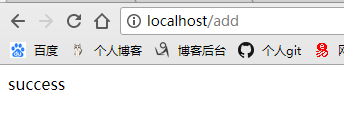======================手动整合=====================
1.手动整合,也就是工具类自己添加缓存
手动整合只需要三步骤:pom.xml引入依赖、配置redis相关设置、 引入redis工具类:
(1)只需要引入下面这个工具类,会自动引入相关依赖的jar包:
<!-- 引入 redis 依赖 --> <dependency> <groupId>org.springframework.boot</groupId> <artifactId>spring-boot-starter-data-redis</artifactId> </dependency>
(2)applications.properties添加如下配置
如果查看默认值我们可以去查看自动配置的类:RedisAutoConfiguration.class。里面的RedisProperties是相关的默认配置以及生效的配置。
############################################################
#
# REDIS 配置
#
############################################################
# Redis数据库索引(默认为0)
spring.redis.database=1
# Redis服务器地址
spring.redis.host=localhost
# Redis服务器连接端口
spring.redis.port=6379
# Redis服务器连接密码(默认为空)
spring.redis.password=
# 连接池最大连接数(使用负值表示没有限制)
spring.redis.pool.max-active=1000
# 连接池最大阻塞等待时间(使用负值表示没有限制)
spring.redis.pool.max-wait=-1
# 连接池中的最大空闲连接
spring.redis.pool.max-idle=10
# 连接池中的最小空闲连接
spring.redis.pool.min-idle=2
# 连接超时时间(毫秒)
spring.redis.timeout=0
(3)引入redis工具类==这里使用spring-redis-data自带的StringRedisTemplate
package cn.qlq.controller; import java.util.Date; import org.springframework.beans.factory.annotation.Autowired; import org.springframework.data.redis.core.StringRedisTemplate; import org.springframework.web.bind.annotation.RequestMapping; import org.springframework.web.bind.annotation.RestController; import com.alibaba.fastjson.JSONObject; import cn.qlq.bean.user.User; import cn.qlq.utils.JSONResultUtil; @RestController @RequestMapping("redis") public class RedisController { @Autowired private StringRedisTemplate strRedis; @RequestMapping("/set") public JSONResultUtil test() { strRedis.opsForValue().set("mycache", "我存入的第一个cache"); return JSONResultUtil.ok(); } @RequestMapping("/setUser") public JSONResultUtil setUser() { User user = new User(); user.setAddress("地址"); user.setCreatetime(new Date()); strRedis.opsForValue().set("user", JSONObject.toJSONString(user)); return JSONResultUtil.ok(); } @RequestMapping("/getUser") public JSONResultUtil getUser() { String string = strRedis.opsForValue().get("user"); User user = JSONObject.parseObject(string, User.class); System.out.println(user); return JSONResultUtil.ok(); } }
这里使用StringRedisTemplate类,该类位于spring-data-redis-xxx.jar中,其有五种操作方式:
redisTemplate.opsForValue();//操作字符串 redisTemplate.opsForHash();//操作hash redisTemplate.opsForList();//操作list redisTemplate.opsForSet();//操作set redisTemplate.opsForZSet();//操作有序set
该类在操作的时候也可以指定key的失效时间,如下:
strRedis.opsForValue().set("mycache", "我存入的第一个cache", 660,TimeUnit.SECONDS);
关于该类的详细使用参考:https://www.jianshu.com/p/7bf5dc61ca06
(4)访问后通过redis客户端查看内容

补充:编写一个简单的工具类对上面的操作进行封装:
package cn.qlq.utils; import java.util.Map; import java.util.Set; import java.util.concurrent.TimeUnit; import org.springframework.beans.factory.annotation.Autowired; import org.springframework.data.redis.core.StringRedisTemplate; import org.springframework.stereotype.Component; @Component public class RedisUtils { @Autowired private StringRedisTemplate redisTemplate; // Key(键),简单的key-value操作 /** * 实现命令:TTL key,以秒为单位,返回给定 key的剩余生存时间(TTL, time to live)。 * * @param key * @return */ public long ttl(String key) { return redisTemplate.getExpire(key); } /** * 实现命令:expire 设置过期时间,单位秒 * * @param key * @return */ public void expire(String key, long timeout) { redisTemplate.expire(key, timeout, TimeUnit.SECONDS); } /** * 实现命令:INCR key,增加key一次 * * @param key * @return */ public long incr(String key, long delta) { return redisTemplate.opsForValue().increment(key, delta); } /** * 实现命令:KEYS pattern,查找所有符合给定模式 pattern的 key */ public Set<String> keys(String pattern) { return redisTemplate.keys(pattern); } /** * 实现命令:DEL key,删除一个key * * @param key */ public void del(String key) { redisTemplate.delete(key); } // String(字符串) /** * 实现命令:SET key value,设置一个key-value(将字符串值 value关联到 key) * * @param key * @param value */ public void set(String key, String value) { redisTemplate.opsForValue().set(key, value); } /** * 实现命令:SET key value EX seconds,设置key-value和超时时间(秒) * * @param key * @param value * @param timeout * (以秒为单位) */ public void set(String key, String value, long timeout) { redisTemplate.opsForValue().set(key, value, timeout, TimeUnit.SECONDS); } /** * 实现命令:GET key,返回 key所关联的字符串值。 * * @param key * @return value */ public String get(String key) { return (String) redisTemplate.opsForValue().get(key); } // Hash(哈希表) /** * 实现命令:HSET key field value,将哈希表 key中的域 field的值设为 value * * @param key * @param field * @param value */ public void hset(String key, String field, Object value) { redisTemplate.opsForHash().put(key, field, value); } /** * 实现命令:HGET key field,返回哈希表 key中给定域 field的值 * * @param key * @param field * @return */ public String hget(String key, String field) { return (String) redisTemplate.opsForHash().get(key, field); } /** * 实现命令:HDEL key field [field ...],删除哈希表 key 中的一个或多个指定域,不存在的域将被忽略。 * * @param key * @param fields */ public void hdel(String key, Object... fields) { redisTemplate.opsForHash().delete(key, fields); } /** * 实现命令:HGETALL key,返回哈希表 key中,所有的域和值。 * * @param key * @return */ public Map<Object, Object> hgetall(String key) { return redisTemplate.opsForHash().entries(key); } // List(列表) /** * 实现命令:LPUSH key value,将一个值 value插入到列表 key的表头 * * @param key * @param value * @return 执行 LPUSH命令后,列表的长度。 */ public long lpush(String key, String value) { return redisTemplate.opsForList().leftPush(key, value); } /** * 实现命令:LPOP key,移除并返回列表 key的头元素。 * * @param key * @return 列表key的头元素。 */ public String lpop(String key) { return (String) redisTemplate.opsForList().leftPop(key); } /** * 实现命令:RPUSH key value,将一个值 value插入到列表 key的表尾(最右边)。 * * @param key * @param value * @return 执行 LPUSH命令后,列表的长度。 */ public long rpush(String key, String value) { return redisTemplate.opsForList().rightPush(key, value); } }
使用方法如下: 注入到需要的缓存对象中
package cn.qlq.controller; import org.springframework.beans.factory.annotation.Autowired; import org.springframework.web.bind.annotation.RequestMapping; import org.springframework.web.bind.annotation.RestController; import com.alibaba.fastjson.JSONObject; import cn.qlq.bean.user.User; import cn.qlq.utils.JSONResultUtil; import cn.qlq.utils.RedisUtils; @RestController @RequestMapping("redis") public class RedisController { @Autowired private RedisUtils redisUtils; @RequestMapping("/getUserByUtils") public JSONResultUtil getUserByUtils() { String string = (String) redisUtils.get("user"); User user = JSONObject.parseObject(string, User.class); System.out.println(user); return JSONResultUtil.ok(); } }
2.整合注解redis缓存
这个整合只不过是将xml配置的方式改为基于java配置的方式进行,之前的xml整合过程已经写的非常详细,参考:https://www.cnblogs.com/qlqwjy/p/8574121.html
定义cacheManager、redisTemplate、keyGenerator,并用注解声明开启缓存。
package cn.qlq.config; import java.lang.reflect.Method; import java.util.Arrays; import org.springframework.cache.CacheManager; import org.springframework.cache.annotation.EnableCaching; import org.springframework.cache.interceptor.KeyGenerator; import org.springframework.context.annotation.Bean; import org.springframework.context.annotation.Configuration; import org.springframework.data.redis.cache.RedisCacheManager; import org.springframework.data.redis.connection.RedisConnectionFactory; import org.springframework.data.redis.core.RedisTemplate; import org.springframework.data.redis.serializer.GenericJackson2JsonRedisSerializer; import org.springframework.data.redis.serializer.StringRedisSerializer; @Configuration // 声明开启缓存 @EnableCaching public class RedisCacheConfig { @Bean public CacheManager cacheManager(RedisTemplate redisTemplate) { RedisCacheManager rcm = new RedisCacheManager(redisTemplate); // 多个缓存的名称,目前只定义了一个(如果这里指定了缓存,后面的@Cacheable的value必须是这里的值) rcm.setCacheNames(Arrays.asList("usersCache", "logsCache")); // 设置缓存过期时间(秒) rcm.setDefaultExpiration(600); return rcm; } @Bean public RedisTemplate<String, String> redisTemplate(RedisConnectionFactory factory) { RedisTemplate template = new RedisTemplate(); template.setConnectionFactory(factory); StringRedisSerializer stringRedisSerializer = new StringRedisSerializer(); GenericJackson2JsonRedisSerializer genericJackson2JsonRedisSerializer = new GenericJackson2JsonRedisSerializer(); template.setKeySerializer(stringRedisSerializer); template.setValueSerializer(genericJackson2JsonRedisSerializer); template.setHashKeySerializer(stringRedisSerializer); template.setHashValueSerializer(genericJackson2JsonRedisSerializer); template.setEnableTransactionSupport(true); return template; } @Bean public KeyGenerator keyGenerator() { return new KeyGenerator() { @Override public Object generate(Object o, Method method, Object... params) { // 规定 本类名+方法名+参数名 为key StringBuilder sb = new StringBuilder(); sb.append(o.getClass().getName()); sb.append("-"); sb.append(method.getName()); sb.append("-"); for (Object param : params) { sb.append(param.toString()); } return sb.toString(); } }; } }
使用方法如下:在使用的地方注解加缓存即可,注意使用更换后的keyGenerator
/** * 分页查询user * * @param condition * @return */ @RequestMapping("getUsers") @Cacheable(value = "usersCache", keyGenerator = "keyGenerator") // 在redis中开启key为findAllUser开头的存储空间 @MyLogAnnotation(operateDescription = "分页查询用户") @ResponseBody public PageInfo<User> getUsers(@RequestParam Map condition) { int pageNum = 1; if (ValidateCheck.isNotNull(MapUtils.getString(condition, "pageNum"))) { // 如果不为空的话改变当前页号 pageNum = Integer.parseInt(MapUtils.getString(condition, "pageNum")); } int pageSize = DefaultValue.PAGE_SIZE; if (ValidateCheck.isNotNull(MapUtils.getString(condition, "pageSize"))) { // 如果不为空的话改变当前页大小 pageSize = Integer.parseInt(MapUtils.getString(condition, "pageSize")); } // 开始分页 PageHelper.startPage(pageNum, pageSize); List<User> users = new ArrayList<User>(); try { users = userService.getUsers(condition); } catch (Exception e) { logger.error("getUsers error!", e); } PageInfo<User> pageInfo = new PageInfo<User>(users); return pageInfo; }
注意@Cacheable的key和keyGenerator是互斥的,两个只能使用一个,查看@Cacheable的源码也可以知道。
结果:

补充:在定义了template之后整合了一个更强大的redis工具类
在RedisCacheConfig中声明bean:
@Bean public RedisTemplateUtils redisTemplateUtils(RedisTemplate redisTemplate) { RedisTemplateUtils redisTemplateUtils = new RedisTemplateUtils(); redisTemplateUtils.setRedisTemplate(redisTemplate); return redisTemplateUtils; }
工具类如下:
package cn.qlq.utils; import java.util.List; import java.util.Map; import java.util.Set; import java.util.concurrent.TimeUnit; import org.springframework.data.redis.core.RedisTemplate; import org.springframework.util.CollectionUtils; /** * * @author QLQ 基于spring和redis的redisTemplate工具类 针对所有的hash 都是以h开头的方法 针对所有的Set * 都是以s开头的方法 不含通用方法 针对所有的List 都是以l开头的方法 */ public class RedisTemplateUtils { private RedisTemplate<String, Object> redisTemplate; public RedisTemplate<String, Object> getRedisTemplate() { return redisTemplate; } public void setRedisTemplate(RedisTemplate<String, Object> redisTemplate) { this.redisTemplate = redisTemplate; } // =============================common============================ /** * 指定缓存失效时间 * * @param key * 键 * @param time * 时间(秒) * @return */ public boolean expire(String key, long time) { try { if (time > 0) { redisTemplate.expire(key, time, TimeUnit.SECONDS); } return true; } catch (Exception e) { e.printStackTrace(); return false; } } /** * 根据key 获取过期时间 * * @param key * 键 不能为null * @return 时间(秒) 返回0代表为永久有效 */ public long getExpire(String key) { return redisTemplate.getExpire(key, TimeUnit.SECONDS); } /** * 判断key是否存在 * * @param key * 键 * @return true 存在 false不存在 */ public boolean hasKey(String key) { try { return redisTemplate.hasKey(key); } catch (Exception e) { e.printStackTrace(); return false; } } /** * 删除缓存 * * @param key * 可以传一个值 或多个 */ @SuppressWarnings("unchecked") public void del(String... key) { if (key != null && key.length > 0) { if (key.length == 1) { redisTemplate.delete(key[0]); } else { redisTemplate.delete(CollectionUtils.arrayToList(key)); } } } // ============================String============================= /** * 普通缓存获取 * * @param key * 键 * @return 值 */ public Object get(String key) { return key == null ? null : redisTemplate.opsForValue().get(key); } /** * 普通缓存放入 * * @param key * 键 * @param value * 值 * @return true成功 false失败 */ public boolean set(String key, Object value) { try { redisTemplate.opsForValue().set(key, value); return true; } catch (Exception e) { e.printStackTrace(); return false; } } /** * 普通缓存放入并设置时间 * * @param key * 键 * @param value * 值 * @param time * 时间(秒) time要大于0 如果time小于等于0 将设置无限期 * @return true成功 false 失败 */ public boolean set(String key, Object value, long time) { try { if (time > 0) { redisTemplate.opsForValue().set(key, value, time, TimeUnit.SECONDS); } else { set(key, value); } return true; } catch (Exception e) { e.printStackTrace(); return false; } } /** * 递增 * * @param key * 键 * @param by * 要增加几(大于0) * @return */ public long incr(String key, long delta) { if (delta < 0) { throw new RuntimeException("递增因子必须大于0"); } return redisTemplate.opsForValue().increment(key, delta); } /** * 递减 * * @param key * 键 * @param by * 要减少几(小于0) * @return */ public long decr(String key, long delta) { if (delta < 0) { throw new RuntimeException("递减因子必须大于0"); } return redisTemplate.opsForValue().increment(key, -delta); } // ================================Map================================= /** * HashGet * * @param key * 键 不能为null * @param item * 项 不能为null * @return 值 */ public Object hget(String key, String item) { return redisTemplate.opsForHash().get(key, item); } /** * 获取hashKey对应的所有键值 * * @param key * 键 * @return 对应的多个键值 */ public Map<Object, Object> hmget(String key) { return redisTemplate.opsForHash().entries(key); } /** * HashSet * * @param key * 键 * @param map * 对应多个键值 * @return true 成功 false 失败 */ public boolean hmset(String key, Map<String, Object> map) { try { redisTemplate.opsForHash().putAll(key, map); return true; } catch (Exception e) { e.printStackTrace(); return false; } } /** * HashSet 并设置时间 * * @param key * 键 * @param map * 对应多个键值 * @param time * 时间(秒) * @return true成功 false失败 */ public boolean hmset(String key, Map<String, Object> map, long time) { try { redisTemplate.opsForHash().putAll(key, map); if (time > 0) { expire(key, time); } return true; } catch (Exception e) { e.printStackTrace(); return false; } } /** * 向一张hash表中放入数据,如果不存在将创建 * * @param key * 键 * @param item * 项 * @param value * 值 * @return true 成功 false失败 */ public boolean hset(String key, String item, Object value) { try { redisTemplate.opsForHash().put(key, item, value); return true; } catch (Exception e) { e.printStackTrace(); return false; } } /** * 向一张hash表中放入数据,如果不存在将创建 * * @param key * 键 * @param item * 项 * @param value * 值 * @param time * 时间(秒) 注意:如果已存在的hash表有时间,这里将会替换原有的时间 * @return true 成功 false失败 */ public boolean hset(String key, String item, Object value, long time) { try { redisTemplate.opsForHash().put(key, item, value); if (time > 0) { expire(key, time); } return true; } catch (Exception e) { e.printStackTrace(); return false; } } /** * 删除hash表中的值 * * @param key * 键 不能为null * @param item * 项 可以使多个 不能为null */ public void hdel(String key, Object... item) { redisTemplate.opsForHash().delete(key, item); } /** * 判断hash表中是否有该项的值 * * @param key * 键 不能为null * @param item * 项 不能为null * @return true 存在 false不存在 */ public boolean hHasKey(String key, String item) { return redisTemplate.opsForHash().hasKey(key, item); } /** * hash递增 如果不存在,就会创建一个 并把新增后的值返回 * * @param key * 键 * @param item * 项 * @param by * 要增加几(大于0) * @return */ public double hincr(String key, String item, double by) { return redisTemplate.opsForHash().increment(key, item, by); } /** * hash递减 * * @param key * 键 * @param item * 项 * @param by * 要减少记(小于0) * @return */ public double hdecr(String key, String item, double by) { return redisTemplate.opsForHash().increment(key, item, -by); } // ============================set============================= /** * 根据key获取Set中的所有值 * * @param key * 键 * @return */ public Set<Object> sGet(String key) { try { return redisTemplate.opsForSet().members(key); } catch (Exception e) { e.printStackTrace(); return null; } } /** * 根据value从一个set中查询,是否存在 * * @param key * 键 * @param value * 值 * @return true 存在 false不存在 */ public boolean sHasKey(String key, Object value) { try { return redisTemplate.opsForSet().isMember(key, value); } catch (Exception e) { e.printStackTrace(); return false; } } /** * 将数据放入set缓存 * * @param key * 键 * @param values * 值 可以是多个 * @return 成功个数 */ public long sSet(String key, Object... values) { try { return redisTemplate.opsForSet().add(key, values); } catch (Exception e) { e.printStackTrace(); return 0; } } /** * 将set数据放入缓存 * * @param key * 键 * @param time * 时间(秒) * @param values * 值 可以是多个 * @return 成功个数 */ public long sSetAndTime(String key, long time, Object... values) { try { Long count = redisTemplate.opsForSet().add(key, values); if (time > 0) expire(key, time); return count; } catch (Exception e) { e.printStackTrace(); return 0; } } /** * 获取set缓存的长度 * * @param key * 键 * @return */ public long sGetSetSize(String key) { try { return redisTemplate.opsForSet().size(key); } catch (Exception e) { e.printStackTrace(); return 0; } } /** * 移除值为value的 * * @param key * 键 * @param values * 值 可以是多个 * @return 移除的个数 */ public long setRemove(String key, Object... values) { try { Long count = redisTemplate.opsForSet().remove(key, values); return count; } catch (Exception e) { e.printStackTrace(); return 0; } } // ===============================list================================= /** * 获取list缓存的内容 * * @param key * 键 * @param start * 开始 * @param end * 结束 0 到 -1代表所有值 * @return */ public List<Object> lGet(String key, long start, long end) { try { return redisTemplate.opsForList().range(key, start, end); } catch (Exception e) { e.printStackTrace(); return null; } } /** * 获取list缓存的长度 * * @param key * 键 * @return */ public long lGetListSize(String key) { try { return redisTemplate.opsForList().size(key); } catch (Exception e) { e.printStackTrace(); return 0; } } /** * 通过索引 获取list中的值 * * @param key * 键 * @param index * 索引 index>=0时, 0 表头,1 第二个元素,依次类推;index<0时,-1,表尾,-2倒数第二个元素,依次类推 * @return */ public Object lGetIndex(String key, long index) { try { return redisTemplate.opsForList().index(key, index); } catch (Exception e) { e.printStackTrace(); return null; } } /** * 将list放入缓存 * * @param key * 键 * @param value * 值 * @param time * 时间(秒) * @return */ public boolean lSet(String key, Object value) { try { redisTemplate.opsForList().rightPush(key, value); return true; } catch (Exception e) { e.printStackTrace(); return false; } } /** * 将list放入缓存 * * @param key * 键 * @param value * 值 * @param time * 时间(秒) * @return */ public boolean lSet(String key, Object value, long time) { try { redisTemplate.opsForList().rightPush(key, value); if (time > 0) expire(key, time); return true; } catch (Exception e) { e.printStackTrace(); return false; } } /** * 将list放入缓存 * * @param key * 键 * @param value * 值 * @param time * 时间(秒) * @return */ public boolean lSet(String key, List<Object> value) { try { redisTemplate.opsForList().rightPushAll(key, value); return true; } catch (Exception e) { e.printStackTrace(); return false; } } /** * 将list放入缓存 * * @param key * 键 * @param value * 值 * @param time * 时间(秒) * @return */ public boolean lSet(String key, List<Object> value, long time) { try { redisTemplate.opsForList().rightPushAll(key, value); if (time > 0) expire(key, time); return true; } catch (Exception e) { e.printStackTrace(); return false; } } /** * 根据索引修改list中的某条数据 * * @param key * 键 * @param index * 索引 * @param value * 值 * @return */ public boolean lUpdateIndex(String key, long index, Object value) { try { redisTemplate.opsForList().set(key, index, value); return true; } catch (Exception e) { e.printStackTrace(); return false; } } /** * 移除N个值为value * * @param key * 键 * @param count * 移除多少个 * @param value * 值 * @return 移除的个数 */ public long lRemove(String key, long count, Object value) { try { Long remove = redisTemplate.opsForList().remove(key, count, value); return remove; } catch (Exception e) { e.printStackTrace(); return 0; } } }
使用方法:
@Autowired private RedisTemplateUtils redisTemplateUtils; @RequestMapping("/setUserByUtils2") public JSONResultUtil setUserByUtils2() { redisTemplateUtils.set("mm", "mm"); return JSONResultUtil.ok(); } @RequestMapping("/getUserByUtils2") public JSONResultUtil getUserByUtils2() { String string = (String) redisTemplateUtils.get("mm"); System.out.println(string); return JSONResultUtil.ok(); }
===============使用springboot的自动整合(不推荐)===============
1.Redis单机版:
(1)第一种:springBootStrap自动配置:
- 目录结构

- 引入spring-boot-starter-redis.jar
<!-- 自动配置Redis --> <dependency> <groupId>org.springframework.boot</groupId> <artifactId>spring-boot-starter-redis</artifactId> <version>1.4.4.RELEASE</version> </dependency>
- SpringBoot运行类打注解开启redis缓存
package cn.qlq; import org.springframework.boot.SpringApplication; import org.springframework.boot.autoconfigure.SpringBootApplication; import org.springframework.cache.annotation.EnableCaching; @SpringBootApplication @EnableCaching//开启redis缓存 public class MySpringBootApplication { public static void main(String[] args) { //入口运行类 SpringApplication.run(MySpringBootApplication.class, args); } }
- application.properties添加redis配置
server.port=80 logging.level.org.springframework=DEBUG #springboot mybatis #jiazai mybatis peizhiwenjian #mybatis.mapper-locations = classpath:mapper/*Mapper.xml #mybatis.config-location = classpath:mapper/config/sqlMapConfig.xml #mybatis.type-aliases-package = cn.qlq.bean #shujuyuan spring.datasource.driver-class-name= com.mysql.jdbc.Driver spring.datasource.url = jdbc:mysql://localhost:3306/test1?useUnicode=true&characterEncoding=utf-8 spring.datasource.username = root spring.datasource.password = 123456 #redis spring.redis.host=localhost spring.redis.port=6379
- Service中打缓存注解:
package cn.qlq.service.impl; import java.sql.SQLException; import java.util.List; import java.util.Map; import org.springframework.beans.factory.annotation.Autowired; import org.springframework.cache.annotation.CacheEvict; import org.springframework.cache.annotation.Cacheable; import org.springframework.stereotype.Service; import cn.qlq.bean.User; import cn.qlq.mapper.UserMapper; import cn.qlq.service.UserService; @Service public class UserServiceImpl implements UserService { @Autowired private UserMapper userMapper; @Cacheable(value="findAllUser",key="1")//在redis中开启key为findAllUser开头的存储空间 public List<User> findAllUser(Map condition) { System.out.println("打印语句则没有走缓存"); List<User> list = userMapper.findAll(); return list; } @Override @CacheEvict(value="findAllUser",allEntries=true)//执行此方法的时候删除上面的缓存(以findAllUser为名称的) public int addUser() throws SQLException { // TODO Auto-generated method stub return userMapper.addUser(); } }
- 测试:
(1)访问:http://localhost/list?name=1(第一次不走缓存)

再次访问:
没有打印语句,也就是没有走方法。
(2)http://localhost/list?name=2(第一次不走缓存)

再次访问:
没有打印语句,也就是没有走方法。
(3)访问:http://localhost/list?name=1
没有打印语句,也就是没有走方法。还是走的缓存。
查看Redis缓存的key:

RedisDesktopManager查看:
- 测试清除缓存:

查看Redis缓存的key发现为空:

总结:
注解上的findAllUser是key的前缀,相当于findAllUser:xxxx,后面的是spring自动根据函数的参数生成,如果redis存在则不走方法,直接取出缓存,如果是参数不同,则走方法且加入缓存。
清除缓存的时候只会清除缓存key前缀是findAllUser开头的,如果是自己手动添加的以findAllUser:开头的也会被清除。如下面的在执行add方法的时候也会被清除:
127.0.0.1:6379> set findAllUser:mykey test
OK